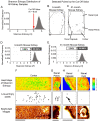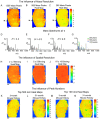Spatial distribution of the Shannon entropy for mass spectrometry imaging
- PMID: 37023018
- PMCID: PMC10079050
- DOI: 10.1371/journal.pone.0283966
Spatial distribution of the Shannon entropy for mass spectrometry imaging
Abstract
Mass spectrometry imaging (MSI) allows us to visualize the spatial distribution of molecular components in a sample. A large amount of mass spectrometry data comprehensively provides molecular distributions. In this study, we focus on the information in the obtained data and use the Shannon entropy as a quantity to analyze MSI data. By calculating the Shannon entropy at each pixel on a sample, the spatial distribution of the Shannon entropy is obtained from MSI data. We found that low-entropy pixels in entropy heat maps for kidneys of mice had different structures between two ages (3 months and 31 months). Such changes cannot be visualized by conventional imaging techniques. We further propose a method to find informative molecules. As a demonstration of the proposed scheme, we identified two molecules by setting a region of interest which contained low-entropy pixels and by exploring changes of peaks in the region.
Copyright: © 2023 Xu et al. This is an open access article distributed under the terms of the Creative Commons Attribution License, which permits unrestricted use, distribution, and reproduction in any medium, provided the original author and source are credited.
Conflict of interest statement
The authors declare no conflict of interest.
Figures





References
Publication types
MeSH terms
LinkOut - more resources
Full Text Sources
Medical
Research Materials

